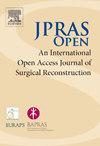Individualized surgical treatment using decellularized fish skin transplantation after enzymatic debridement: A two years retrospective analysis
IF 1.5
Q3 SURGERY
引用次数: 0
Abstract
Over the past few years, treatment of burn injuries has evolved beyond primary surgical therapy with the development of enzymatic debridement and new types of skin replacement materials by providing complex personalized therapy concepts aimed at preserving and replacing the dermal layer of the skin.
The aim of our study was to develop an individualized treatment algorithm for mixed depth burn wound and evaluate the outcomes of individualized combined treatment of mixed depth burn wounds with enzymatic debridement and decellularized fish skin.
A total of 18 patients with a mean age of 34.8 years and mean follow-up of 447.6 days were included. The mean total burn surface area was 12.3%. All patients received enzymatic debridement and an average area of 247.2 cm2 of decellularized fish skin. Days until complete epithelization were 49.4 ± 25.79 days. No patient developed scar contracture or keloid. The Patient and Observer Scar Assessment Scale (POSAS) observer scale showed an overall impression average of 2.2 ± 0.83. The POSAS patient scale showed an overall impression average 2 ± 0.7. The Vancouver Scar Scale showed an average score of 1.89 ± 1.45. In conclusion, combined treatment using enzymatic debridement and decellularized fish skin, polylactide membrane, or split skin grafts allows for a more individualized therapy for mixed depth burn wounds. Fish skin was found to provide a satisfying result in terms of the overall outcome of the developed scar tissue and could lead to a reduction in the area that requires autologous transplantation.
酶清创后采用去细胞鱼皮移植个体化手术治疗:两年回顾性分析
在过去的几年里,随着酶清创和新型皮肤替代材料的发展,烧伤的治疗已经超越了最初的手术治疗,提供了复杂的个性化治疗理念,旨在保护和替换皮肤的真皮层。本研究的目的是开发混合深度烧伤创面的个体化治疗算法,并评估酶清创和脱细胞鱼皮混合深度烧伤创面个体化联合治疗的效果。共纳入18例患者,平均年龄34.8岁,平均随访447.6天。平均总烧伤面积为12.3%。所有患者均接受酶清创,平均面积为247.2 cm2的脱细胞鱼皮。至上皮完全形成的时间为49.4±25.79天。无患者出现瘢痕挛缩或瘢痕疙瘩。患者与观察者疤痕评估量表(POSAS)观察者评分的总体印象平均值为2.2±0.83。POSAS患者评分总体印象平均为2±0.7。温哥华疤痕量表平均得分为1.89±1.45分。总之,使用酶清创和去细胞鱼皮、聚乳酸膜或裂皮移植的联合治疗可以为混合深度烧伤创面提供更个性化的治疗。研究发现,就瘢痕组织的整体结果而言,鱼皮提供了令人满意的结果,并且可以减少需要自体移植的区域。
本文章由计算机程序翻译,如有差异,请以英文原文为准。
求助全文
约1分钟内获得全文
求助全文
来源期刊

JPRAS Open
Medicine-Surgery
CiteScore
1.60
自引率
0.00%
发文量
89
审稿时长
22 weeks
期刊介绍:
JPRAS Open is an international, open access journal dedicated to publishing case reports, short communications, and full-length articles. JPRAS Open will provide the most current source of information and references in plastic, reconstructive & aesthetic surgery. The Journal is based on the continued need to improve surgical care by providing highlights in general reconstructive surgery; cleft lip, palate and craniofacial surgery; head and neck surgery; skin cancer; breast surgery; hand surgery; lower limb trauma; burns; and aesthetic surgery. The Journal will provide authors with fast publication times.
 求助内容:
求助内容: 应助结果提醒方式:
应助结果提醒方式:


